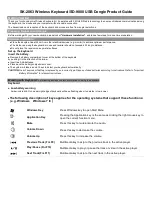
T
he F
CC
W
ant
s
Yo
u t
o
K
now
2
6*'
(%%
9#065
;17
61
-019
This equipment has been tested and found
to comply with the limits for a Class B digital
device, pursuant to Part 15 of the
FCC
Rules. These limits are designed to provide
reasonable protection against harmful
interference in a residential installation. This
equipment generates, uses and can radiate
radio frequency energy and, if not installed
and used in accordance with the
instructions, may cause harmful interference
to radio communications.
However, there is no guarantee that
interference will not occur in a particular
installation. If this equipment does cause
harmful interference to radio or television
reception, which can be determined by
turning the equipment off and on, try to
correct the interference by one or more of
the following measures:
• Reorient or relocate the receiving
antenna.
• Increase the separation between the
equipment and receiver.
• Connect the equipment into an outlet on
a circuit different from that to which the
receiver is connected.
• Consult your local RadioShack store or
an experienced radio/TV technician for
help.
If you cannot eliminate the interference, the
FCC requires that you stop using your
keyboard.
You must use shielded interface cables with
this equipment.
%100'%6+0)
219'4
You can power your keyboard using internal
batteries or standard AC power with an
optional AC adapter.
+
056#..+0)
$
#66'4+'5
Your keyboard can use 6 AA batteries (not
supplied) for power. For the best per-
formance and longest life, we recommend
RadioShack alkaline batteries.
1. Make sure
POWER/MODE
is set to
OFF
.
2. Press the tab on the battery
compartment cover on the bottom of the
keyboard, then pull up the cover to
remove it.
3. Place the batteries in the compartment
as indicated by the polarity symbols (+
and –) marked inside.
4. Replace the cover.
When the keyboard stops operating
properly, replace the batteries.
R
7
5+0)
#%
2
19'4
You can power the keyboard using a 9V,
800 mA AC adapter and a size M
Adaptaplug™ adapter (neither supplied).
Both are available at your local RadioShack
store or online at
www.radioshack.com.
Connecting an AC adapter automatically
disconnects any internal batteries.
1. Make sure
POWER/MODE
is set to
OFF
.
2. Set the AC adapter’s voltage switch to
9V
.
3. Insert the Adaptaplug adapter into the
adapter’s cord so it reads – TIP.
4. Connect the AC adapter’s barrel plug to
DC 9V
on the back of the keyboard.
5. Plug the AC adapter’s other end into a
standard AC outlet.
Always disconnect the AC adapter when you
finish using the keyboard.
%100'%6+0)
*'#&2*10'5
To listen to your keyboard without disturbing
others, you can connect an optional pair of
stereo headphones with a
1
/
4
-inch (6.35 mm)
plug. RadioShack sells a wide selection of
headphones. Insert the headphones’ plug
into
PHONES/OUTPUT
on the back of the
keyboard. Connecting headphones
disconnects the keyboard’s built-in
speakers.
.
+56'0+0)
5
#('.;
To protect your hearing, follow these
guidelines when you use headphones.
• Set the volume to the lowest setting
before you begin listening. After you
begin listening, adjust the volume to a
comfortable level.
• Do not listen at extremely high volume
levels. Extended high-volume listening
can lead to permanent hearing loss.
• Once you set the volume, do not
increase it. Over time, your ears adapt
to the volume level, so a volume level
that does not cause discomfort might
still damage your hearing.
%106'065
The FCC Wants You to Know ...................... 2
Connecting Power ....................................... 2
Installing Batteries .................................... 2
Using AC Power ....................................... 2
Connecting Headphones ............................. 2
Listening Safely ........................................ 2
Connecting an External Amplifier ................ 3
Using the Sheet Music Stand ...................... 3
A Quick Look at Your Keyboard ................... 4
Basic Operation ........................................... 5
Auto Power Off/Power On Alert ................ 5
Playing the Prerecorded Tunes ................... 5
Selecting/Playing Back a Specific Tune ... 5
Consecutively Playing Back All the Tunes 5
Using the Preset Tones ................................ 5
Selecting/Playing a Preset Tone ............... 5
Layered Tones .......................................... 5
Keyboard Split Tones ................................ 5
Percussion Sounds ................................... 6
Using the Preset Auto-Rhythms .................. 6
Selecting/Playing an Auto-Rhythm ........... 6
Using SYNCHRO ..................................... 6
Using FILL-IN ........................................... 6
Using Auto Accompaniment ........................ 6
Concert Chord .......................................... 7
Standard Fingering ................................... 7
Using Lesson Mode ..................................... 8
Playing the Left-Hand Part ....................... 8
Changing the Tone of a
Prerecorded Tune ..................................... 9
Turning Key Lighting Off ........................... 9
Special Features .......................................... 9
Changing Keys ......................................... 9
Tuning the Keyboard ................................ 9
Troubleshooting ......................................... 10
Care ........................................................... 10
Service and Repair .................................... 10
Standard Fingering Chord Charts .............. 11
Rhythm List ................................................ 14
Specifications ............................................. 15
%#76+10
Installing Batteries
•
Use only fresh batteries of the required size
and recommended type.
•
Do not mix old and new batteries, different
types of batteries (standard, alkaline, or
rechargeable), or rechargeable batteries of
different capacities.
•
If you do not plan to use the keyboard with
batteries for a week or more, remove the
batteries. Batteries can leak chemicals that
can destroy electronic parts.
Using AC Power
You must use a Class 2 power
source that supplies 9V DC and
delivers at least 800 mA. Its
center tip must be set to negative and its
plug must fit the keyboard's DC 9V jack.
Using an adapter that does not meet these
specifications could damage the keyboard
or the adapter.
•
Always connect the AC adapter to the
keyboard before you connect it to AC
power. When you finish, disconnect the
adapter from AC power before you
disconnect it from the keyboard.
!
R
9#40+0)
R
Dispose of old batteries promptly and properly.
Do not burn or bury them.
T
h
e
F
CC W
a
nt
s You t
o
K
now

































